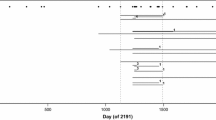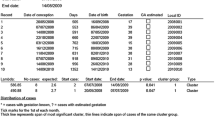Abstract
Clusters of adverse reproductive outcomes are reported with increasing frequency to public health authorities. Most are random events and only a very small proportion is likely due to identifiable environmental agents. Often, a preliminary study confirms the existence of a spatial and temporal excess but no biologically plausible cause is found. These cases require a follow-up of incidence to identify any continuing excess. A conceptually simple ‘fixed window’ technique of follow up is proposed. The power of the test is mainly influenced by the magnitude of the increase in rate, the number of adverse outcomes selected for observation and the acceptable false alarm rate. This technique has several advantages compared with other currently used methods. From a public health point of view, two important factors are to be considered in setting the parameters of the test: the delay in providing an answer for the community and the availability of resources for conducting environmental investigations.
Similar content being viewed by others
References
Greenberg M, Wartenberg D. Communicating to an alarmed community about cancer clusters: A fifty state survey. J Community Health 1991; 16: 71–82.
Gregg NM. Congenital cataract following German measles in the mother. Transact Ophthalmol Soc Austral 1941; 3: 35–46.
Harada Y, Noda K. How it came about the finding of methyl mercury poisoning in Minamata district. Congenital Anomal 1988; 128 Suppl: 59–69.
McBride WG. Thalidomide and congenital abnormalities. Lancet 1961; ii: 1358.
Lenz W. Thalidomide and congenital abnormalities. Lancet 1962; i: 45.
Herbst AL, Ulfelder H, Poskanzer DC. Adenocarcinoma of the vagina: Association of maternal stilbestrol therapy with tumor appearance in young women. New Engl J Med 1971; 284: 878–881.
Whorton D, Krauss RM, Marshall S, et al. Infertility in male pesticide workers. Lancet 1977; ii: 1259–1261.
Källen B. Epidemiology of human reproduction. Boca Raton, Florida: CRC Press, 1988.
Rothman KJ. A sobering start for the cluster busters conference. Am J Epidemiol 1990; 132Suppl 1: 6–13.
Neutra RR. Counterpoint from a cluster buster. Am J Epidemiol 1990; 132: 1–8.
US Department of Health and Human Services. Guidelines for investigating clusters of health events. Mort Morb Wkly Rep 1990; 39 RR-11: 1–23.
Minnesota Department of Health, Chronic Disease and Environmental Epidemioloy Section. Cancer cluster protocol. Minneapolis, MN: Minnesota Department of Health, 1990.
Fiore BJ, Hanrahan LP, Anderson HA. Public health response to reports of clusters. Am J Epidemiol 1990; 132Suppl 1: 14–22.
Devier JR, Brownson RC, Bagby JR, et al. A public health response to cancer cluster in Missouri. Am J Epidemiol 1990; 132Suppl 1: 23–31.
California Department of Health services. Investigating non-infectious disease clusters. Emeryville, CA: California Department of Health services, Environmental Health Investigation Branch, 1990.
Fleming LE, Ducatman AM, Shalat SL. Disease clusters in occupational medicine: A protocol for their investigation in the workplace. Am J Industr Med 1992; 22: 33–47.
Weatherall JAC, Haskey J. Surveillance of malformations. Br Med Bull 1976; 32: 39–44.
Chen R. A surveillance system for congenital malformations. J Am Stat Assoc 1978; 73: 323–327.
Chen R, Connelly RR, Mantel N. Analysing post-alarm data in a monitoring system in order to accept or reject an alarm. Stat Med 1993; 12: 1807–1812.
Author information
Authors and Affiliations
Rights and permissions
About this article
Cite this article
Niyonsenga, T., De Wals, P. A method for the follow-up of clusters of adverse reproductive outcomes. Eur J Epidemiol 15, 833–837 (1999). https://doi.org/10.1023/A:1007517830120
Issue Date:
DOI: https://doi.org/10.1023/A:1007517830120




